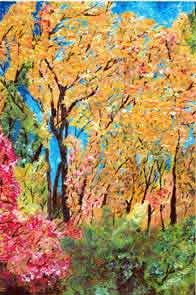 As a cancer biologist, Dr. Kornelia (Nelly) Polyak pores over countless images of breast cancer cells and their surrounding tissues, data tables, and graphs – visuals that only a scientist can find beautiful.
As a cancer biologist, Dr. Kornelia (Nelly) Polyak pores over countless images of breast cancer cells and their surrounding tissues, data tables, and graphs – visuals that only a scientist can find beautiful.
But when she sits down to paint, Polyak fills large canvases with a riot of vivid and deeply saturated colors, with thick brushstrokes rendering landscapes like purple fields of lavender in France, red-tiled houses on the Italian coast, and lush English gardens.
Polyak’s chosen medium is acrylic paint applied with little water and so thick that it resembles oils. She has been inspired by the Impressionist painters, including Monet and Manet and especially Van Gogh, with his bright colors and wide brush strokes.
Despite the contrasts, her scientific and artistic sides share some fundamental ways of thinking, says Polyak, who has been studying art and painting since her school days. In both, she says, “You need the creativity – you need to envision something and make it real.”
When her former postdoctoral adviser Dr. Bert Vogelstein at Johns Hopkins interviews applicants for lab positions, she says, “He always asks if they are doing some kind of art because he thinks there is so much connection between art and science – a link in the brain.” She notes that many scientists, at Dana-Farber and elsewhere, are deeply involved in music, dance, photography, and other forms of artistic expression.
“Everyone needs something to charge their batteries that keeps you going and helps you handle things that sometimes aren’t so pleasant, especially in fields like oncology,” she says.
Polyak heads the Breast Cancer Genetics Laboratory at Dana-Farber and Harvard Medical School. Her research focuses on identifying differences between normal and cancerous breast tissue, determining their consequences and utilizing them to improve the lives of breast cancer patients.
In 2011, she was one of two young investigators at Dana-Farber who were honored with the Paul Marks Prize for Cancer Research.
Over the years, many researchers attending Polyak’s scientific talks have seen her art, as she sometimes includes slides of her paintings with the slides of scientific data.
“People ask about them, and then they ask if they can have them,” she says. “I don’t really like to give them away – but sometimes I do.”
See some of Polyak’s paintings on her laboratory’s website.
